Eating a minimalist diet means keeping your food choices simple. It’s about giving up strict and complicated diets for a way of eating that nourishes your body more simply and intuitively.
For the rest of this article, we’ll be digging deep into what a minimalist diet is and is not.
But first, let’s clear up a couple terms so we’re on the same page:
Minimalism
It’s important to note what exactly minimalism is: a simple, intentional lifestyle, with a focus on internal satisfaction rather than external things and consumerism.
As with all aspects of minimalism, there is no “one size fits all” way to do it.
Diet
Let’s also clear up the term “diet”. Commonly we think a diet means “going on a diet” (especially in reference to weight loss diets).
In reality, a diet is simply a way of eating. A minimalist diet then is a pattern of eating that doesn’t eliminate any particular foods or have any strict rules.
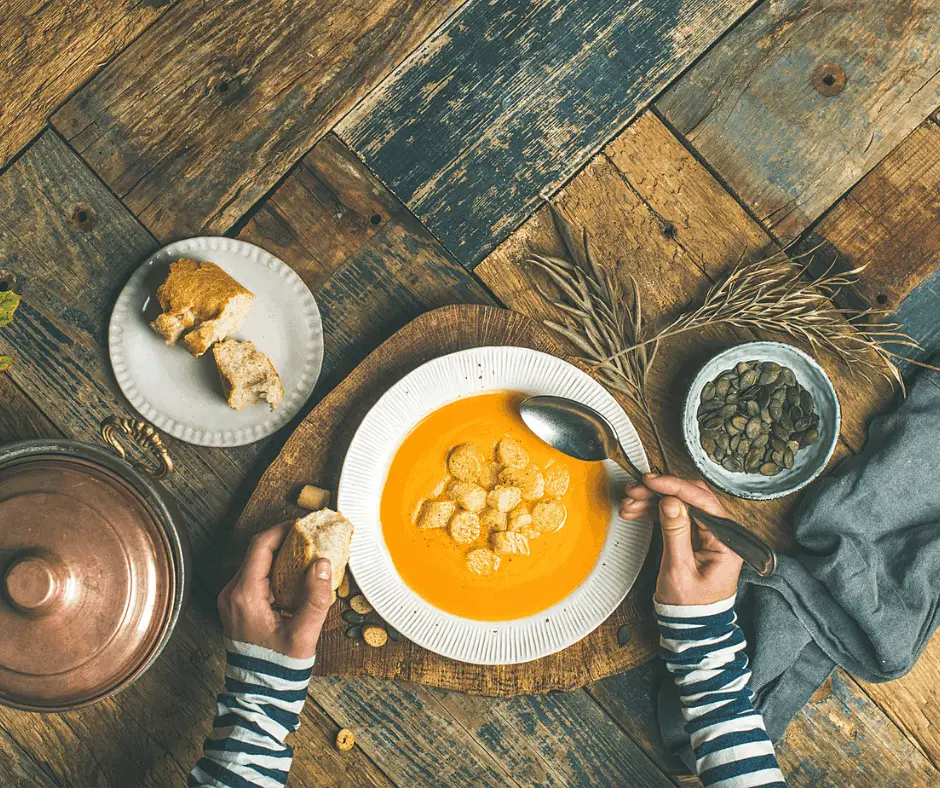
What does minimalist eating mean?
Is a minimalist diet about following a meal plan formula to minimize choice and decision fatigue about what to eat?
Is it about eating only simple, whole foods?
Is it about using only minimal ingredients in foods and recipes?
Does it encompass a whole minimalist kitchen aesthetic with clear counters and only the basic kitchen tools?
Is it about simplifying the whole routine of cooking and eating?
Streamlining the time spent planning, shopping, prepping, cooking and cleaning up after meals, so that time can be spent on other things that are more important to you?
Could a minimalist diet even include not cooking at all like using a meal delivery service?
What about zero waste?
I don’t really have the answer, and yet the answer could be that any or all of these could be considered part of a minimalist diet.

This page contains affiliate links which means I may earn a commission if you use them, at no additional cost to you. See disclosure policy for details. There’s no one right way to be a minimalist, and there’s no one right minimalist diet.
What exactly is a minimalist diet?
I think what some common threads are: simple food choices, not elaborate or lavish, few but high quality ingredients, minimal packaging, minimal processing, minimal waste.

There is no right or wrong way to eat. A healthy version of a minimalist eating pattern should be a set of guidelines more than hard set rules.
Guidelines will help you get where you want to be without causing guilt or anxiety if you “break the rules” or “cheat”.
The way you eat should make you feel good, energized, and flexible. Feeling stressed, guilty, or restricted is a sign you’ve taken the rules too seriously and need to take a step back.
Of all the ways to eat like a minimalist, there are a few common patterns:
A diet comprised of simple, minimalist foods
- choose simple, whole foods with few ingredients
- choose simple recipes comprised of the same core ingredients
- only keep a few fresh spices on hand
- season simply
A minimalist diet could be comprised of food ratios
This works really well for a typical western diet and the meat-and-potato type of person.
For example, 1/4 plate protein, 1/4 plate carbs, 1/2 plate veggies. This is along the guidelines of Canada’s Food Guide or USDA MyPlate guide.
Because it’s simply a ratio, the actual ingredients could vary from day to day.
For example, one meal might be roasted salmon, potatoes, and broccoli. Another meal might be meatloaf, rice, and steamed vegetables.
It also works in mixed meals, like stirfry with chicken, veggies, and rice. Just use the approximate ratios when cooking and serving your meal!
Remember that these are just guidelines and not meant to be followed as strict rules. Some days your meals will look different and that’s perfectly ok!
A minimalist meal plan
A minimalist meal plan would be one that is very similar from day to day and from meal to meal. For example, oatmeal for breakfast, salad for lunch, hot meal for supper.
This would be great for someone looking to follow a simple eating pattern, reduce decision fatigue, or meal prep. Imagine never having to figure out what to pack for lunch, because you have the same lunch each day!
To ensure you get enough variety in your diet, I recommend having a series of meals you can substitute for each other. For example, you might have 4 go-to salads for lunch and mix them up from week to week:
- a couscous & chickpea salad with cucumber and tomato
- a greek salad with chicken and farro
- a black bean, corn & quinoa salad
- roasted veggie salad
For more information on how to actually implement a minimalist diet meal plan, get the Minimalist Meal Planning Workbook!
In the Minimalist Meal Planning Workbook you will learn how to meal plan without:
- spending as much time planning as it takes to cook a meal
- using up a lot of brain power
- eating the same things over and over
- getting overwhelmed and giving up (again!)
If this sounds like something you need, get it here!
The Minimalist Meal Planning Workbook completely simplifies meal planning and takes you step-by-step through the process so you can stick with it once and for all!
In this article, learn 3 reasons why you need a minimalist meal plan
A minimalist diet is comprised of simple, easy recipes
This minimalist is looking to simplify cooking and eating. The key focus is to choose minimalist recipes which have just a few simple steps and use few ingredients.
You may not even have to follow a recipe they’re so simple!
Take a stir fry for example: start rice. Meanwhile, cut up vegetables and protein, stir fry in oil until almost done. Add sauce. Serve over rice.
Same goes for a sheet pan meal: Preheat oven. Chop veggies, potatoes and protein. Toss with oil and seasonings in a bowl. Spread on sheet pan and roast for about 40 minutes, or until done.
- Use base recipes like stir fry, soup, curry, sheet pan meal
- choose simple recipes with 10 ingredients or less (give or take)
- season simply. You don’t need 45 herbs, spices and sauces. Just keep basics on hand that all go together so you can whip up a tasty seasoning in no time.
- Keep the cooking method simple. You don’t need all burners going at once trying to cook everything and make a sauce from scratch.

Despite these different ways of minimalist eating, the majority of minimalists share these traits:
- only buy what you need
- cook most meals at home
- keep pantry organized & neatly labelled
- simple kitchen tools
- keep the counter clear
- minimize food waste
- stock basic ingredients. You don’t need every sauce, seasoning, shape of pasta, etc.
- focus on simple, whole, minimally processed foods
The basics of minimalist food
Minimalist foods are simple, whole, minimally processed foods. Minimalist food is made into simple meals with few ingredients and steps. Think: sheet pan meals or one pot meals with 10 ingredients or less.
The majority of a minimalist’s diet is composed of core foods that are minimally processed and minimally packaged. Most meals are cooked at home.
This is not to say that a true minimalist never eats packaged and processed food or takeout. Simply that MOST of a healthy minimalist diet is comprised of simple, whole foods.
When it comes to what you eat, do not restrict. The 80/20 rule is a good guideline. That is, on average, about 80% simple, minimalist food, 20% other foods is a good balance.
Minimalist Food List:
- Vegetables
- Fruit
- Nuts & seeds
- Whole grains
- Beans & legumes
- High quality oil like olive or avocado oil
- Poultry, meat & fish (optional)
See the full list of budget friendly pantry staples for minimalists.
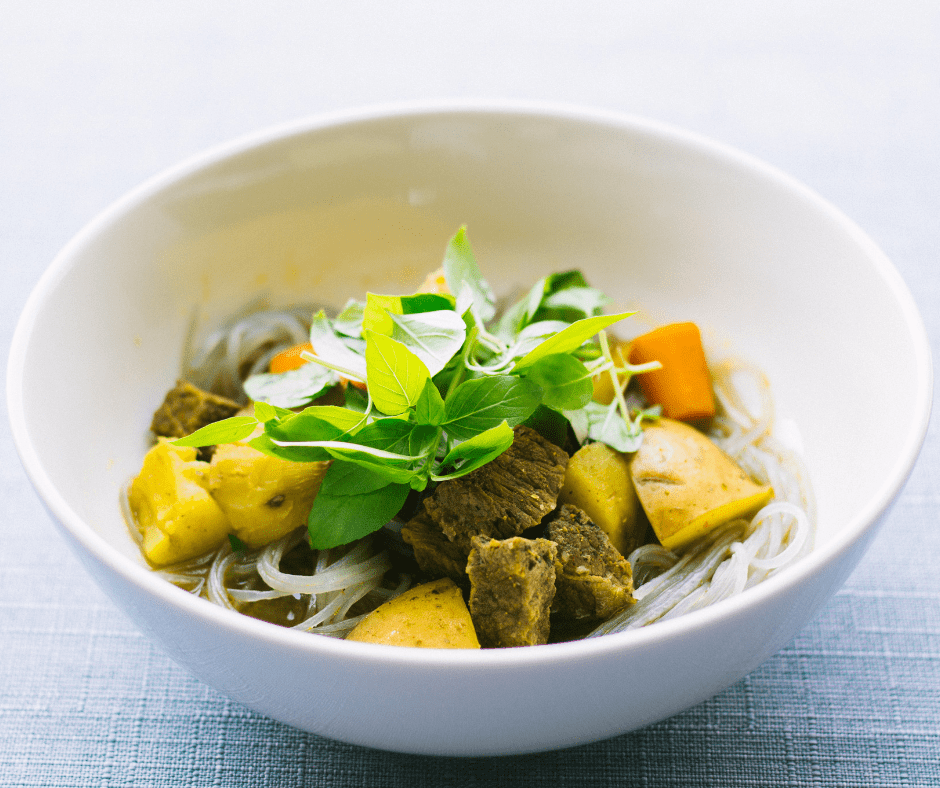
Pros of Minimalist Eating:
- tends to be healthy & balanced diet
- allows you to put your minimalist lifestyle into practice
- may be less expensive than a conventional diet. Ie: less takeout & ready-made foods
- may help you try new recipes, cooking techniques & ingredients
Cons of Minimalist Eating:
- may be more expensive than a conventional diet. Ie: more fresh, unprocessed foods which may be more expensive (depending what you were eating before)
- may be unobtainable for some. Ie: access to these foods may be limited in lower income or more rural areas.
- more time consuming. Ie: fewer processed foods generally means more time cooking (but not always!)
- may only focus on minimalism aspect of food while decreasing the importance of other aspects of food such as socialization, enjoyment, food preferences
- may lead to moralistic emphasis on foods. Ie: good vs bad foods
- may lead to excessive food rules
Should I eat a minimalist diet?
Honestly, only you can answer that question for yourself. I think most people would be able to incorporate at least some of the principles of a minimalist diet.
If you’re on a tight budget you can be a bit more frugal by following a minimalist diet most easily by buying simple ingredients and cooking from scratch more often.
If you’d like to eat healthier while following a minimalist diet, buying simple, whole foods is a step in the right direction.
If you want to simplify your life, using recipes with few ingredients and simple steps will help you achieve that while becoming a bit more minimalist.
Minimalist Diet FAQs
A minimalist diet is a way of eating that includes simplifying food choices, shopping, and cooking, while nourishing your body intuitively.
The most minimalist diet is eating intuitively with the fewest food rules possible. The more rules you have about what foods you should or shouldn’t eat, the less minimalist the diet is.
As you’ve seen in this post, there is no one “minimalist diet”, it’s more about finding what works to simplify your own life.
Minimalist eating uses some principles of intuitive eating such as rejecting the weight loss diet mentality and incorporating gentle nutrition practices.
They differ though in the way that minimalist eating still focuses on choosing certain foods more often than others, whereas intuitive eating encourages listening to what your body needs. What your body needs in that moment may be a simple home-cooked meal or it may be fast food.
In a minimalist diet, fast food would be considered part of the foods to focus less on (20% of foods) while simple home cooked meals would be 80% of what we eat. In intuitive eating, all foods are considered equal.
Mindful eating and minimalist eating are similar in that they both focus on making intentional food choices. Since a minimalist lifestyle is heavily influenced by making mindful choices, it makes sense that a minimalist’s diet is a form of mindful eating.
A paleo diet is not a minimalist diet. The paleo diet consists of a lot of food rules telling you what you should and should not eat. A minimalist diet eliminates external food rules and is more mindful by listening to what works for your own body.
A keto diet is not appropriate for minimalists. While, yes, most of the foods “allowed” in a keto diet are quite simple, there are many food rules that make it difficult to follow for most people.
The keto diet relies on following external food rules whereas a minimalist diet eliminates external food rules and is more mindful by listening to what works for your own body.
Eating a plant-based diet is a complimentary way of eating to a minimalist diet. There are not a lot of food rules, just the guideline that most of the foods are plant-based.
There are several forms of intermittent fasting, but generally speaking it is not a minimalist diet because it requires you to follow rules about when you can eat. A minimalist diet doesn’t subscribe to external food rules.
A vegan or vegetarian diet and a minimalist diet are not the same things, but you could easily incorporate the principles of each way of eating if you wanted to.
A traditional Japanese diet is quite minimalist; simple homemade preparations of vegetables, rice, seafood, and sauces. It makes sense because Japanese minimalism comes from core cultural focus on simplicity, which is also a core concept of minimalism.
The minimalist diet is not a weight loss diet, it’s a way of eating that is meant to be followed for life, not a short term goal like weight loss.
The “minimalist diet” is actually a way of eating simply and intuitively, not a set of external rules that tells you what or how to eat. It’s about developing a system based on what simplifies your unique situation.
Whatever you choose, assess how it’s working for you and get the Simple, Money-Saving Meal Ideas Workbook to help you implement it!
Minimalist eating is such an individual experience. What kind of minimalist diet do you eat? Comment below!
For more information on how to actually implement a minimalist diet, get the workbook!
In the Minimalist Meal Planning Workbook you will learn how to meal plan without:
- spending as much time planning as it takes to cook a meal
- using up a lot of brain power
- eating the same things over and over
- getting overwhelmed and giving up (again!)
If this sounds like something you need, get the workbook here!
The Minimalist Meal Planning Workbook completely simplifies meal planning and takes you step-by-step through the process so you can stick with it once and for all!
Keep Reading:
Eat Simply With These Tips From a Dietitian
Minimalist Grocery Shopping List
Minimalist Kitchen: Ideas to Design & Organize Your Dream Kitchen!
Frugal Minimalist Kitchen Essentials List
Frugal Minimalist Pantry Staples
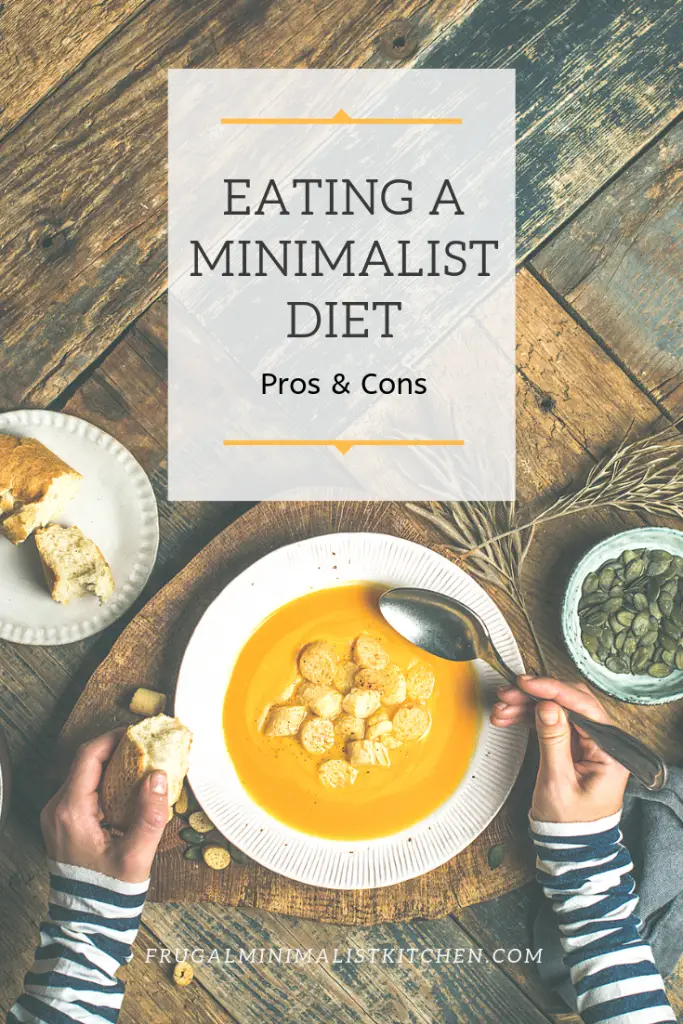
5 Comments on Eating a Minimalist Diet (Dietitian Approved!)
Leave a Reply

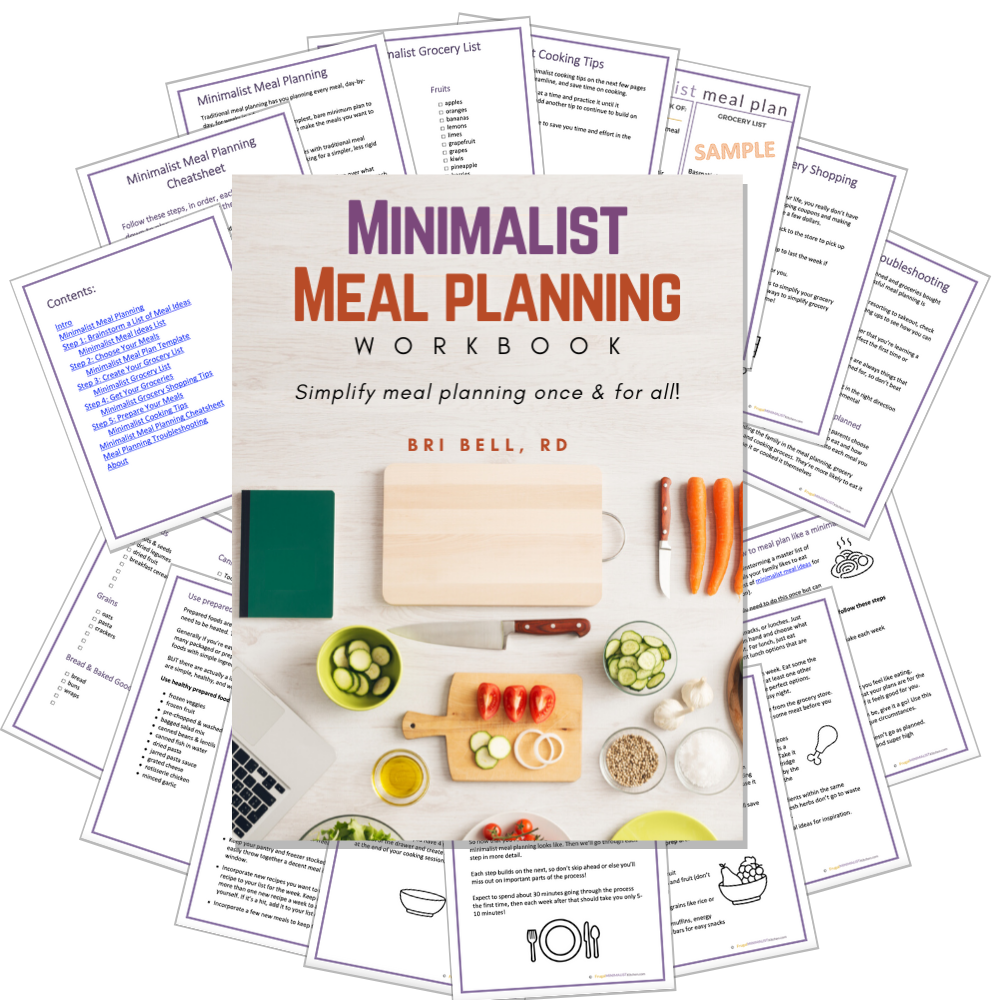
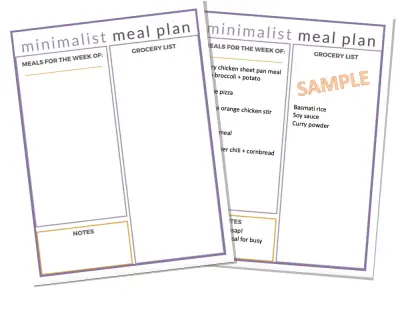
When I was younger I really enjoyed cooking and creating fancy dishes especially for guests. When I just cooked for myself though I cooked very simply. However, now that I’m much older I find myself getting simpler and quicker in producing meals. One of our staples is anything with beans & rice which is very versatile and fun to add veggies, corn & cheese. For breakfast we either eat cereal with fruit or I make a oat, apple, nut & raisin bar. Sometimes I’ll use other fruit but we both really like apples.
Your information has some great ideas that I hadn’t even thought about. I find I am becoming a minimalist without even knowing what I was doing…cleaning out my closet (no more heels for me, yay), cleaning the fridge out (tackling the freezer soon), even trimming down on dog treats (finding one loves apples, the other not so much), etc.
The most important thing to me is that I find myself enjoying my new minimalist attitudes.
So, thank you for helping me realize where I’m headed and all your help!
This is awesome! I appreciate you sharing 🙂
im vegan minimalist and i support buying fresh food.
eat what the field grow, no need process anything. fruit vegy grains nuts beans.
nature give everything we need. no need make it fancy the palate adjusts after some time and starts to taste the actual food without dumping tons of sugar, sauce, spice.
A minimalist diet changed my life & saved so much cash
This is so helpful Bri! It’s easy to get distracted in the modern world of fancy matcha lattes, 30-ingredient recipes… sometimes taking it back to the utmost basics is the best step towards a happy & healthy kitchen.
Absolutely!